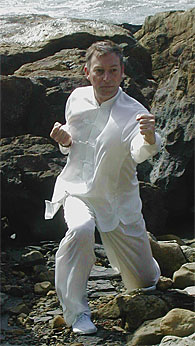|
Xingyi Quan: Mind Intent Boxing |
|
Xingyi’s direction is linear and stresses the use of vertical strength and the fist.
In the case of Xing Yi, the concepts of the interplay of yin and yang are expressed fully in the complete name of the system ‘Heart-Mind Six Harmonies Boxing,’ the name given it by Ji Long Feng.
The Six Harmonies are comprised of three yin and three yang. As regards the three Internal Harmonies, the heart/desire harmonises with the intent; the intent harmonises with the Qi or vital energy; the Qi harmonises with the physical strength. Concerning the three External Harmonies, the shoulders harmonise with the hips; the elbows harmonise with the knees, and the hands harmonise with the feet.
|
|
Since its inception, Xing Yi itself has been regarded by many Chinese military historians of later times as the internal boxing system most adaptable to the needs of military combat.
The origins of Xing Yi Quan, the oldest of the Three Sister Internal Arts, are shrouded in mystery, for legend attributes its creation to the renowned Song Dynasty general, Yue Fei (1103-1141 CE), who created a boxing style called ‘Xin Yi Liu He Quan’ [Heart-Mind Six Harmonies Boxing].
|
|
| The earliest verifiable historical information concerning this System refers to Ji Long Feng – who lived during the early 1600’s towards the end of the Ming Dynasty - of Shanxi Province as being the first to teach the art of Xin Yi Liu He Quan. Ji Long Feng was a great master of spear fighting techniques, from which he drew inspiration for the creation of the Xing Yi System. The philosophic concepts on which the system is built provide yet another instance of the influence upon the martial arts of core ancient Chinese metaphysical and spiritual concepts, found in their most concentrated and vibrant form in Daoism. |
|
